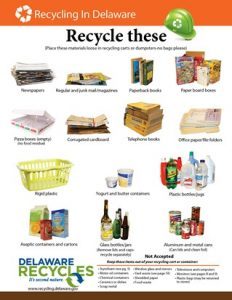 DOVER – To help Delaware’s schools, businesses and institutions start recycling programs or expand programs already in place, DNREC is once again offering the Universal Recycling Grants and Low Interest Loan Program – with up to $1 million in funding available this year for successful grant proposals.
DOVER – To help Delaware’s schools, businesses and institutions start recycling programs or expand programs already in place, DNREC is once again offering the Universal Recycling Grants and Low Interest Loan Program – with up to $1 million in funding available this year for successful grant proposals.
Recycling Refrigerator Magnet – Recycling Grant and Low Interest Loans webpage
DNREC, in collaboration with the Recycling Public Advisory Council (RPAC), is placing emphasis on:
- Distribution of preapproved recycling instructional information to influence positive recycling behaviors at the point where recyclable material is generated and disposed of (e.g. kitchen, office, workplace, recycling bin, cart, dumpster);
- Recycling outreach – which covers recycling advertising, education, and related initiatives;
- School or university recycling programs;
- Source-separated food waste recycling infrastructure development, and
- Business, non-profit, community organization, or local government recycling programs
Everything listed above encompasses the various projects and expenses that may be funded by the University Recycling Grants and Low Interest Loan Program – as could other projects that fall outside of recycling priority areas. Creativity is encouraged when applying and all eligible applications will be given consideration to the extent that recycling grant and loan program resources allow. RPAC and DNREC’s recycling program stress that applicants for grants and low-interest loans do not need to be a recycling expert to put forward a recycling grant project.
Governor Jack Markell said DNREC’s recycling grant and low interest loan program is a key component in continuing to drive momentum for Universal Recycling in Delaware. “I’m proud of the progress we’ve achieved in making recycling accessible and practical,” Gov. Markell said. “That experience has shown that we can cost-effectively reduce the amount of waste dumped in landfills and be good stewards of our environment while promoting economic growth, and it’s important that we continue to build on that effort.”
“DNREC’s grant and loan program is again geared toward helping schools and businesses save money and reduce their environmental footprint by recycling in Delaware,” said DNREC Secretary David Small. “We want the grants to help businesses and organizations double the recycling rate across the commercial sector and achieve statewide goals for Universal Recycling championed by Governor Markell. We’re now closer to another goal – of every Delawarean having access to recycling at home, at work, at school and making recycling a way of life in the First State.”
DNREC is announcing two grant opportunities for 2016 which will be the seventh and eighth rounds of Recycling Grant and Low Interest Loan offerings since the program started in 2011. The first opportunity to apply for funding runs through June 22 (Cycle 7). The second opportunity to apply runs Aug. 17 through Nov. 2 (Cycle 8). Cycle 7 grant and loan awards are expected to be announced in August, Cycle 8 awards in December.
Application forms and a guidance document are available at dnrec.delaware.gov/dwhs/Pages/RecyclingGrants.aspx, or via Delaware’s recycling website at recycling.delaware.gov. Applicants are advised to read the guidance document prior to submitting their applications. Though most applicants request grant funding, low-interest loans are also available. Grant applicants who may be partially awarded are also eligible for loans to supplement their project costs.
The Universal Recycling Grant and Low Interest Loan Program was created by the state’s Universal Recycling Law. The law provides a framework to ensure recycling services in Delaware are effective and easily accessible. Commercial sector entities are expected to be actively participating in recycling programs. The commercial sector includes any for-profit or not-for profit retail or wholesale stores, offices, food service establishments, warehouses, and other manufacturing, industrial or processing activities, and institutions such as social, charitable, educational, health care, professional and government services.
Schools, business owners, and institution managers are encouraged to learn about the growing recycling opportunities in Delaware. Recycling can be economically beneficial when organizations reduce their disposal costs. To learn more about requirements, grant funding, commercial recycling toolkits, recycling grant opportunities and more, please visit recycling.delaware.gov or call 302-739-9403, ext. 8.
Media Contact: Michael Globetti, DNREC Public Affairs, 302-739-9902
Vol. 46, No. 109